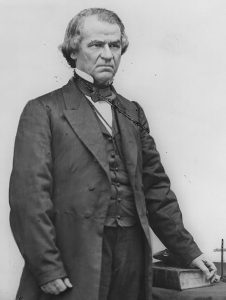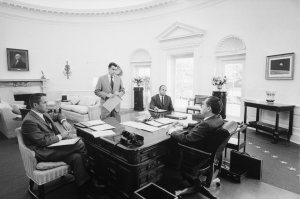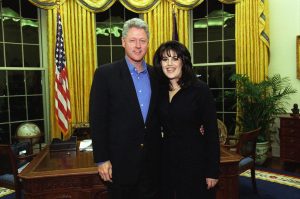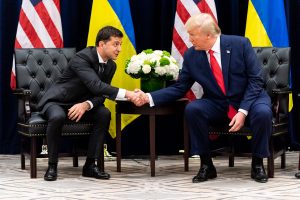4.6: Impeachment and Removal of the President
- Page ID
- 134550
“No point is of more importance than that the right of impeachment should be continued. Shall any man be above Justice? Above all shall that man be above it, who can commit the most extensive injustice? . . . Shall the man who has practiced corruption & by that means procured his appointment [election] in the first instance, be suffered to escape punishment, by repeating his guilt?”
–George Mason (1)
Members of the executive and judicial branch officials can be impeached and removed. Executive branch officials who get into trouble tend to resign, or the president removes from office. In 1804, the House impeached sitting Supreme Court Justice Samuel Chase, but he survived the trial in the Senate. In 1969, Supreme Court Justice Abe Fortas resigned under threat of impeachment for financial improprieties. Eight federal judges have been impeached and removed from office. An additional three federal judges have been impeached and resigned before they completed their Senate trials. The charges against these judges ranged from sexual assault to bribery and perjury. (3)
It is the prospect of a president being impeached and removed that is the most interesting and historically significant possibility examined in this section. The founders were aware that neither ancient Grecian or Roman societies had figured out how to peacefully remove a chief executive who was abusing his office—often assassination or uprisings were the only remedies. Thus far, no U.S. president has been impeached by the House and removed by the Senate.
Impeachment Power
Even though the British monarch could not be impeached him/herself, the House of Commons proclaimed that impeachment was a principal instrument to hold royal power accountable. In the American colonies—particularly after 1755 and then intensifying in the 1770s—colonial assemblies “came to see impeachment as the mechanism by which the people could begin the process of ousting official wrongdoers, understood as those who betrayed republican principles, above all by abusing their authority through corruption or misusing power.” (5) After independence, several states put impeachment provisions in their state constitutions.
The U.S. Constitution's impeachment process is to be applied to any future president who had, in the words of Benjamin Franklin, “rendered himself obnoxious” to the Constitutional order and the rule of law. The president, vice president, and other civil U.S. officers can be removed from office by Congress if they are found guilty of “treason, bribery, or other high crimes and misdemeanors.” While the definitions of treason and bribery are clear, the phrase “other high crimes and misdemeanors” sometimes confuses people. However, the founders were quite clear about what they meant. George Mason originally proposed that the House be able to impeach in cases of treason, bribery, or “maladministration,” but that was deemed to be too broad a term. Instead, they chose the phrase “or other high crimes and misdemeanors,” which had precedent in English law going back to 1642.
The founding fathers were particularly concerned about presidents who fraudulently achieved office, who might be under the influence of—or conspire with—foreign powers, who improperly enriched themselves, who undermined the rule of law, or who became incapacitated. (6) It is clear that the president’s offenses need not be law violations and could instead be technically legal assaults against the common good or the public trust. For example, Alan Hirsch argues that it is perfectly legal for a president to pardon all members of his own party for any federal offenses, but such action would be reasonable grounds to impeach and remove that president. (8)
The impeachment process is a fairly straightforward one. At its most basic, constitutionally removing a president is a two-step process:
- The impeachment process begins in the House of Representatives, where one or more members introduces a bill to impeach. This bill is referred to the House Judiciary Committee, which will hold hearings and vote whether to report out articles of impeachment to the full House. Other relevant House committees may hold hearings as well. Articles of impeachment are essentially the specific charges against the president. The full House debates the articles of impeachment and votes; a successful majority vote on one of the charges means that the president has been impeached.
- Then the process moves to the Senate, where the president is put on trial and the senators determine whether the president is “guilty” of the offenses spelled out in the articles of impeachment. Members of the House Judiciary Committee come over to the Senate to present the case against the president, while the president’s lawyers mount a defense. The Chief Justice of the Supreme Court comes into the Senate to preside over the trial. The Constitution requires a two-thirds vote in the Senate to convict and remove the president.
Congress has never gone through the whole process and successfully removed a sitting president. However, there have been four notable cases in U.S. history.
Andrew Johnson

In the 1864 presidential election, Republican Abraham Lincoln chose Democrat Andrew Johnson as his running mate in an effort to reach out to Democrats who supported the Union’s war effort. The Lincoln-Johnson ticket won. After Lincoln's assassination on April 14-15, 1865, Johnson became president. At this time, the Republican Party’s Radical Republican wing was adamant that the defeated Southern states be “reconstructed” into loyal Union members and that African Americans be guaranteed political rights and full participation. Johnson was more inclined to be lenient with the former Confederate states, which included his home state of Tennessee. Indeed, he did not believe that blacks were capable of democratic governance and said in 1865 that “White men alone must manage the South.” (9) He vetoed the 1866 Civil Rights Act and the Freedmen’s Bureau bill, which were designed to enlarge and solidify the powers of the already existing Freedmen’s Bureau to protect the civil rights and liberties of newly freed slaves and refugees. His action angered the Radical Republicans, and Congress overrode his vetoes. Johnson also opposed passing the Fourteenth Amendment, which granted former slaves citizenship. It passed anyway.
To limit Johnson’s power, Congress passed the Tenure of Office Act in 1867, which said that the president could not remove the holders of any appointed positions unless the Senate concurred. When Johnson removed Secretary of War Edwin Stanton without the Senate’s approval and replaced him with Lorenzo Thomas, the House voted to impeach him for the clear violation of the Tenure of Office Act. They also impeached him for very derogatory statements he made about Congress, specifically that he “did attempt to bring into disgrace, ridicule, hatred, contempt and reproach to the Congress of the United States.” (That’s not a crime, although they impeached him for it anyway.) After a three-month trial in 1868, President Johnson’s opponents came one vote short of a two-thirds majority to remove him from office. He served out the remainder of his term. Interestingly, the Tenure of Office Act was repealed in 1887. Later, the Supreme Court definitively ruled in Meyers v. United States (1926) that the president does not need Senate approval to fire executive branch officials.
Richard Nixon

On June 17, 1972, agents of President Richard Nixon’s Committee for the Re-Election of the President (CREEP) were caught breaking into the Democratic Headquarters in the Watergate office and residential complex. Nixon immediately tried to cover up the incident by ordering hush money payments and telling the Federal Bureau of Investigation to not look into it. The cover-up ultimately did not work, and the revelations that followed constituted a shock to the American public that reverberated for decades.
Nixon did everything he could to forestall the inevitable. In the famous Saturday Night Massacre, Nixon ordered Attorney General Elliot Richardson to fire Archibald Cox, who was serving as the independent special prosecutor in the case. Richardson resigned rather than carry out the order. Nixon then ordered Deputy Attorney General William Ruckelshaus to fire Cox. Ruckelshaus also refused to do it and resigned. Then Nixon asked Solicitor General Robert Bork to fire Cox, and Bork complied.
Other elements of corruption came to light. Nixon and his subordinates were responsible for extorting money from rich individuals and corporations; spying on U.S. citizens because they disagreed with the president’s policies; trying to use the Internal Revenue Service to destroy “enemies” of the president; selling government favors in exchange for campaign contributions; seriously contemplating the murder of a journalist; and breaking into psychiatrists’ offices looking for dirt on opponents. (10)
Nixon had a taping system in the White House that recorded his conversations with everyone who came into his office. When faced with a congressional subpoena, he refused to turn over the tapes until forced by a unanimous Supreme Court decision. United States v. Nixon (1974) established that while the president had the right to confidentially record conversations with his advisors, executive privilege did not extend to refusing to turn over records pertinent to a criminal proceeding. Apparently, Nixon contemplated refusing to turn over the tapes, as well as pardoning the bunglers and those people who had already been convicted and indicted. But, in the end, he decided to comply with the Supreme Court’s order. (11)
The tapes revealed the cover-up’s “smoking gun”: Nixon suggested to his chief of staff that the FBI tell the CIA to stay out of the Watergate investigation because it dealt with national security issues—an assertion that was not true and that clearly indicated obstruction of justice. Nixon resigned the presidency on August 9, 1974, just before the full House had a chance to vote on accepting three articles of impeachment. By resigning before he was actually impeached by the House, Nixon was eligible to be pardoned by Gerald Ford, who assumed the presidency after Nixon’s resignation.
Bill Clinton

The House of Representatives voted along party lines in 1998 to impeach President Bill Clinton. The complicated story can be distilled as follows: While he was still governor of Arkansas, Clinton allegedly propositioned an Arkansas state employee named Paula Jones in a Little Rock hotel. With support from conservatives, including lawyer Kenneth Starr, Jones pursued a sexual harassment lawsuit against now President Clinton. Later, Kenneth Starr would become the independent counsel charged with investigating a variety of non-sexual allegations against Clinton and his wife. Starr eventually failed to find enough evidence that the Clinton’s ever did anything impeachable in their finances or in running the White House.
During depositions in the Paula Jones case designed to demonstrate Clinton’s pattern of sexual harassment, the president was asked whether he had had “sexual relations” with Monica Lewinsky, a former White House intern. She was asked a similar question. Clinton and Miss Lewinsky both said that they had not had sexual relations, when in fact they had. Independent Counsel Starr received this information from Paula Jones’ lawyers and went to Attorney General Janet Reno to get his investigative mandate extended to cover this salacious affair. The Attorney General agreed to grant Starr’s request, although Starr allegedly hid from Reno the fact that he had an obvious conflict of interest in this case. (12) Both Clinton and Lewinsky were brought before Starr’s grand jury to testify, and they again stated that they did not have sexual relations. In the meantime, the president’s secretary recovered gifts Clinton had given Lewinsky. Finally, the Independent Counsel’s report indicated that Clinton and Lewinsky had ten “sexual encounters” short of actual intercourse. (13)
The House passed two articles of impeachment that centered on his under-oath perjury and his obstruction of justice by encouraging others to perjure and conceal evidence. The case’s facts were not really in dispute: Clinton did what the House alleged. When the impeachment case reached the Senate, Clinton survived by a comfortable margin, with only fifty of the required sixty-seven senators voting to convict. Very few people outside of the president’s staunchest political allies argued that Clinton’s testimony did not constitute perjury—he clearly gave false statements under oath in a federal case.
The debate in the Clinton impeachment revolved around two issues:
- Did lying under oath in court about an embarrassing extramarital affair constitute a serious enough offense to remove the president? a
- How much damage did the Clinton scandal—with its salacious details—do to the presidency’s moral authority?
In the end, the broad national consensus was that Republican efforts to impeach and remove Clinton amounted to an overly moralistic and politically opportunistic overreaction to a scandal that in no way threatened the Constitutional order.
Donald Trump

As a businessman who inherited wealth from a father who flouted the law, Trump’s conduct before taking up his position in the White House allegedly included tax fraud, running a fraudulent foundation, running a fraudulent university, bilking subcontractors, posing as a publicist and praising himself to a reporter, and engaging in sexual harassment and assault. (14) During the 2016 campaign, Trump flouted post-Nixon custom and refused to release his tax returns. He also paid off at least two women to keep their adulterous sex stories out of the news during the campaign.
Once in office, President Trump engaged in numerous potentially impeachable offenses that included
- violating the Constitution’s emoluments clause by accepting money from foreign governments
- obstructing justice by firing FBI Director James Comey when he opened up an investigation into Russian ties to the Trump campaign
- obstructing justice with respect to Special Counsel Robert Mueller’s Russian ties to the Trump campaign investigation
- violating his duty to see that laws are executed by advocating violence perpetrated by various supporters and law enforcement personnel
- abusing his pardon power in the cases of Joe Arpaio and the pardons for war crimes, thereby undermining the rule of law
- committing crimes against humanity for separating children from their parents at the U.S. border, placing them in inhumane conditions and having no plan to reunite them when their cases were adjudicated
- violating campaign finance laws while he was president by reimbursing his personal lawyer Michael Cohen and by discussing sexual-affair hush money payments in the Oval Office. (15)
Trump was not impeached for any of those possible offenses. However, he would become the first president to be impeached twice.
First Impeachment--In late 2019, the House of Representatives impeached President Trump on a party-line vote because a whistle-blower came forward with a claim: Trump’s months-long conspiracy to use his office and taxpayer resources for his personal political benefit to get Ukraine to announce that it sought to investigate Democratic presidential candidate Joe Biden. Trump compounded his troubles by refusing to release any relevant documents—except a summary of two calls between Trump and the Ukrainian president—or to allow any administration personnel to testify to the House Intelligence Committee about the matter. Several people involved in or knowledgeable of the conspiracy came forward and testified anyway, but principals including the president’s personal lawyer Rudy Giuliani, Secretary of State Mike Pompeo, Acting Director of the Office of Management and Budget Mick Mulvaney, former National Security Advisor John Bolton, Vice President Michael Pence, Attorney General William Barr, and several other staff followed Trump’s direction and refused to come forward during the House investigation.
Ultimately, the House passed two articles of impeachment:
- Abuse of power by soliciting foreign interference in the 2020 election and compromising the national security of the United States
- Obstruction of Congress by the categorical and indiscriminate defiance of lawful Congressional subpoenas for information and testimony in an impeachment investigation
Republican senators blocked all attempts to request relevant documents and interview eyewitnesses to Trump’s alleged abuse of power. It was the first impeachment trial that heard from no witnesses and introduced no documents into the record. As far as the Republican senators were concerned, “facts and evidence—reality—were viewed as grave threats, which is why they had to be buried.” (16)
Trump’s defense team didn’t attempt to present counter evidence—instead, they sought to rationalize the president’s actions—and Republican senators acknowledged that the president did what was alleged in the articles of impeachment. (17) One Republican senator attempted to get Chief Justice John Roberts to reveal the name of the whistleblower, but Roberts refused. During the trial, the Government Accountability Office confirmed that the president’s actions violated the Impoundment Control Act. (18) Bolton’s upcoming book manuscript alleged that Pat Cipollone, the White House Counsel and part of Trump’s legal team, participated in the criminal conspiracy. (19)
In the end, all Republicans except for Senator Mitt Romney (R-UT) voted “not guilty” on both articles of impeachment, and all Democrats voted “guilty” on both articles of impeachment—a result that fell far short of the two-thirds vote needed to remove Trump from office. Senator Romney voted “yes” on the abuse of power charge and “no” on the obstruction of Congress charge.
Two legacies of the Trump impeachment are likely to have long-term consequences.
- Getting away with blanket obstruction of a congressional inquiry--An executive whose actions cannot be investigated by Congress and who has a compliant Justice Department is more like an all-powerful monarch than an U.S. president. That’s a frightening precedent for the Senate to set.
- A president could exercise his legal authority to declassify national security secrets for another country in exchange for that country’s help with his re-election. It is a way of thinking that subsumes the national interest of the United States underneath the personal political interest of the president.
Second Impeachment--Called to action by Trump, thousands of his supporters gathered in Washington, D.C., on January 5 and 6 to support his false claim that the 2020 election had been "stolen by emboldened radical-left Democrats" and to demand that Vice President Mike Pence and Congress reject Biden's victory. Starting at noon on January 6, at a "Save America" rally, Trump repeated false claims of election irregularities and said, "If you don't fight like hell, you're not going to have a country anymore."
As a result, a mob of 2,000–2,500 his supporters attacked the Capitol Building in Washington, D.C. They sought to overturn his defeat in the 2020 presidential election by disrupting the joint session of Congress assembled to count electoral votes that would formalize President-elect Joe Biden's victory. The Capitol Complex was locked down and lawmakers and staff were evacuated as rioters assaulted law enforcement officers, vandalized property, and occupied the building for several hours. Five people died either shortly before, during, or following the events. Many people were injured, including 138 police officers.
On January 13, 2021, Trump was impeached on one article: incitement of insurrection. At the conclusion of the trial, the Senate voted 57–43 to convict Trump of inciting insurrection, falling 10 votes short of the two-thirds majority required by the Constitution. It's important to note that he was leaving the presidency on January 20 anyway. Thus, removal from office would only have prevented him from becoming president again at a later date.
References
- As recorded in James Madison’s notes on July 20, 1787. Yale Law School’s Avalon Project.
- Keith Whittington, “The Power to Impeach Executive Officers,” Lawfare. August 4, 2017.
- Elizabeth Nix, “Has a U.S. Supreme Court justice ever been impeached?” History.com. December 2, 2016.
- Laurence Tribe and Joshua Matz, To End a Presidency. The Power of Impeachment. New York: Basic Books, 2018. Page 2. The Benjamin Franklin quote comes from page 1.
- Cass R. Sunstein, Impeachment. A Citizen’s Guide. Cambridge, Massachusetts: Harvard University Press, 2017. Page 39.
- Note that the 25th Amendment later set up a formal process outside of impeachment to remove a president who is incapacitated.
- Tribe and Matz, To End a Presidency. Page 59.
- Alan Hirsch, Impeaching the President: Past, Present, and Future. San Francisco: City Lights Books, 2018. Page 23.
- Jon Meacham, “Andrew Johnson,” in Jeffrey Engel, Jon Meacham, Timothy Naftali, and Peter Baker, Impeachment. An American History. New York: Modern Library, 2018. Page 49.
- Jerry Zeifman, Without Honor: Crimes of Camelot and the Impeachment of Richard Nixon. New York: Thunder’s Mouth Press, 1996. Fred Emery, Watergate: The Corruption of American Politics and the Fall of Richard Nixon. New York: Simon & Schuster, 1995.
- Timothy Naftali, “Richard Nixon,” in Jeffrey Engel, Jon Meacham, Timothy Naftali, and Peter Baker, Impeachment. An American History. New York: Modern Library, 2018. Pages 144-145.
- Eric Lichtblau and Allan C. Miller, “House Democrats Push for an Investigation of Starr’s Office,” Los Angeles Times. February 11, 1999.
- Washington Post, The Starr Report: The Findings of Independent Counsel Kenneth W. Starr on President Clinton and the Monica Lewinsky Affair. Public Affairs Reports, 1998.
- David Cay Johnston, The Making of Donald Trump. Brooklyn, NY: Melville House, 2017. Michael Kranish and Marc Fisher, Trump Revealed. The Definitive Biography of the 45thPresident. New York: Scribner, 2017. Steve Reilly, “Hundreds Allege Donald Trump Doesn’t Pay His Bills,” USA Today. June 9, 2016.
- Ron Fein, John Bonifaz, and Ben Clementz, The Legal Case for a Congressional Investigation on Whether to Impeach President Donald J. Trump. Free Speech for People. December 6, 2017. Trump’s 10 Impeachable Offenses. Need to Impeach.
- Peter Wehner, “The Downfall of the Republican Party,” The Atlantic. February 2, 2019.
- Christal Hayes, “’He Shouldn’t Have Done It.’ GOP Senator Who Scolded Trump on Ukraine Explains Why He Backs Acquittal.” USA Today. February 1, 2020. Chris Cillizza, “Marco Rubio’s Mind-Blowing Explanation of His Impeachment Vote,” CNN. February 1, 2020.
- Dareh Gregorian, ”Trump Administration Violated the Law by Withholding Ukraine Aid, Government Accountability Office Says,” CBS News. January 16, 2020.
- Travis Gettys, “’Holy Crap!’ Bolton ‘Directly Implicated’ Pat Cipollone as a ‘Fact Witness’ in Trump Impeachment Trial,” Rawstory. January 31, 2020.
- Dershowitz quoted by Allan Lichtman in “What Will the History Books Say About This Impeachment?” Politico. February 5, 2020.
Media Attributions
- Impeachment Johnson © Library of Congress is licensed under a Public Domain license
- Impeachment Nixon © Hartmann is licensed under a Public Domain license
- Impeachment Clinton © White House Photograph Office is licensed under a Public Domain license
- Impeachment Trump © Shealah Craighead is licensed under a Public Domain license

